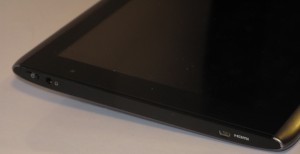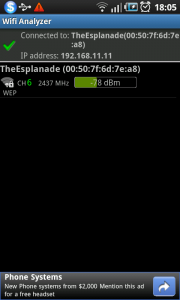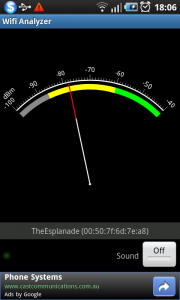The Android technology doesn’t stop at handsets or tablets anymore at this year’s CES.
In the car
Parrot are premiering the “Asteroid” which is an Android-powered car radio / multimedia player. It has USB for connectivity to iOS devices, USB flash memory, wireless-broadband modems and GPS pucks at the moment as well as line input for regular audio devices. I am not sure what Bluetooth or hands-free calling abilities it has at the moment but this could change by the time it is released. Of course it has FM radio and, through the 3G connectivity and an Android app, could support Internet radio in the car as well as being a media player and GPS navigation device. It has a power output of 55W x 4 but also has three preamplifier outputs (front, rear, subwoofer) so it can be the head unit for the most tricked-out sound system on the street. Oh yeah, boys!
Similarly, Fujitsu Ten are previewing an satellite-navigation unit which is powered by the Android operating system. The main issue with these Android systems at the moment is that the Google “Android Marketplace” doesn’t support them because they use an interface that is dissimilar to the handset or tablet devices. Here, Parrot or Fujitsu Ten will either have to contract with an Android app store to supply applications to these devices and this app store would have to support the user interfaces provided by automotive Android devices.
In other car-tech news, Ford have developed an AppLink system so that specific iOS apps can be operated from the car’s dashboard. As well, General Motors have developed an IOS link to their OnStar vehicle telematics system but the main problem with these systems is that they necessitate an extra app on the smartphone for each marque. This is compared to Terminal Mode which the European vehicle builders are implementing, which allows one piece of software on the smartphone for many different vehicles and suits the reality that most of us will drive different vehicle marques through our driving life and even have regular access to two or more different vehicles.
As well, GM are intending to implement the PowerMat wireless-charging system in the American-market vehicles from model-year 2011 onwards. This allows devices with Powermat charging circuitry, whether integrated or as an add-on module to be charged or powered on a special mat wirelessly. I have wondered whether this announcement will then apply to GM nameplates other than Buick, Cadillac, Chevrolet or GMC or other markets.
Networked Home Entertainment
Video Entertainment and the Home Theatre
As far as video-based home entertainment goes, 3D video still rules the roost with every one of the major camera names from Japan with a 3D camera or camcorder in their model lineup. As well, every major TV brand that serves the US market is selling a 3D flatscreen TV in their model lineup. Most of the manufacturers are working on 3D viewing technologies that either don’t need glasses or can work with lightweight glasses. This also includes some manufacturers establishing design partnerships with glasses-frame designers to make attractive 3D-viewing glasses.
But there is a lot more action when it comes to network-enabled TVs and video peripherals This is again driven by the supply of “over-the-top” Internet video services like Netflix and Hulu Plus. It is also being helped along by manufacturers building up “app platforms” which allow the user to download apps to the TV as if it was like one of the smartphones. It can capture the reality of interactive TV as well as use of common Internet services like Twitter, YouTube and Facebook from the comfort of your couch. As well, programs like Skype are being implemented on these TVs in order to make them become large-screen video-conferencing units for the home or small business.
LG have supplied the ST600 Smart TV kit, which is an add-on kit for selected (or all?) LG TVs to link them to the Internet and the DLNA Home Media Network. As well, one of their pico-projectors that they had on show is equipped with an digital-TV tuner and can stream content from a DLNA Media Server.
Sony now has it that all of their new Blu-Ray players are all DLNA and Gracenote enabled/ They all can quickly start a Blu-Ray movie and have support for the “Media Remote” RF link with Wi-Fi-enabled iOS or Android device running a specific app. These same features are also available to their Blu-Ray home theatre systems.
As well, most of the Sony BRAVIA TV range released this year will be network-enabled with DLNA, Internet TV, Skype large-screen videophone and similar functionality. Some models will have integral 802.11n Wi-Fi functionality while the lower-cost models will require a dongle to connect to the Wi-Fi network. This really shouldn’t worry most users because they could use direct Ethernet or HomePlug AV links to connect the TV to the home network.
The Skype videophone function will work with an optional USB webcam / microphone kit that will be available from Sony.
As well, most of the TVs and home-theatre systems honour the full HDMI 1.4 expectation with Audio Return Channel. This means that the sound from the TV’s integrated sources like the digital TV tuner travel back to the home theatre amplifier using the same HDMI cable used to connect the TV to that amplifier. There is no need to use extra digital cable runs to have properly-decoded surround sound from TV broadcasts received via the TV’s tuner.
As well, Sony has released a network-audio product that makes Apple squirm when it comes to their Airport Express and AirPlay subsystem. This product which comes in the form of the HomeShare speakers connects to a Wi-Fi home network and can play out audio content under the control of a UPnP AV (DLNA) Control Point like Windows 7 or TwonkyMedia Manager. This same control functionality is also available in Sony’s latest Blu-Ray Players as well as the NAS-SV20 and NAS-SV10i iPhone docks.
Samsung have come around with a Blu-Ray player that is the thinnest such player ever. This Wi-Fi-enabled player can be wall-mounted and, in my honest opinion, is cutting in on Bang & Olufsen’s “design AV” territory.
They also are releasing the D6000 TVs which work with RVU compliant pay-TV gateways. This standard, which is a superset of DLNA for pay TV applications). enables access to the full pay-TV feature suite like pay-per-view or video-on-demand without the TV being connected to the pay-TV operator’s set-top box/ This concept has been proven to works with an RVU server box that links to DirecTV’s satellite pay-TV service.
Iomega have also released a Boxee TV set-top box which is similar to D-Link’s unit. But the similarity stops here because it has integrated NAS functionality with DLNA Media Server. It is capable of working with Ethernet wired or 802.11n Wi-Fi networks and uses a double-side remote with QWERTY keyboard. It is available as an enclosue or with a 1Tb or 2Tb hard disk.
Vizio, a low-cost TV brand in the US similar to Kogan, is to implement Via Plus (Google TV) in their Internet-enabled TVs. They will be providing apps that link to Hulu Plus, Blockbuster On Demand, and other popular “over-the-top” TV services. These sets will also have Skype functionality when used with a USB webcam. Vizio will also be implementing glasses-free 3DTV and are dabbling in 21:9 ultra-widescreen TV
Cisco have been focusing on the interactive TV front but in a different way. They sell the Scientific Atlanta set-top boxes on contract to cable and satellite providers and are implementing an app platform on their newer boxes. This also means that they are providing a “VideoScape” content-selection experience so that users can find the content they are after or look for related content easily.
JVC have released the first “soundbar” speaker system which implements the HDMI 1.4 Audio Return Channel. Here, this technology comes in to its own with these speakers because the sound from the TV emerges through the easy-to-set-up soundbar unit.
Internet radios
Grace Digital have released three Internet radios that have a similar user interface to the Grundig TrioTouch stereo Internet radio or the Revo IKON stereo Internet radio. Here, these sets use as their primary user interface a colour LCD display with icons laid out in a grid not dissimilar to a smartphone or tablet. The Mondo is designed to be a full-on clock radio for the bedside and has a 3.5” display, Ethernet and line-out connectivity and a remote. The Solo Touch is a tuner that connects to one’s favourite music system and has a large 4/3” touchscreen. It connects to the home network via Ethernet. The Bravado X is a stereo table radio with line in / out and has a 2.7” display. These units can also be controllable via a smartphone app which is available for the iOS only at the moment.
As well, Vizio have jumped on the Android bandwagon by providing a stereo table radio which operates on the Android platform. This one is controlled by a colour LCD touchscreen like the typical smartphone. It would most likely would have an Internet-radio app and also pull in music from a DLNA Media Server device.
The next article in the series will focus on network-infrastructure technologies for the small network and what is being offered here.






